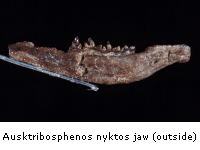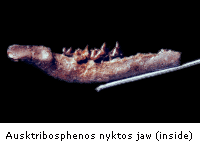Dinosaur Dreaming
Backgrounder:
A Tribosphenic Mammal from the Mesozoic of Australia
Dr. Tom Rich,
Museum of Victoria

The
jaw of a tiny mammal that lived alongside polar dinosaurs was collected southeast
of Melbourne, Australia, on the 8 of March, 1997. Clearly neither an egg-laying
monotreme (echidnas and platypus) nor a pouched marsupial (such as kangaroos and
wombats) the specimen presents a puzzle to scientists. It appears to belong either
to the third major group of living mammals, the placentals (which include horses,
cats, bats, whales and people) or it is a totally new group of mammals closely
related to the placentals.

This
discovery is the culmination of a 23-year National
Geographic Society-sponsored program seeking the origins of Australia's unique
mammals and birds. The program was conceived and executed by Professor Pat Vickers-Rich
of Monash University and Dr. Tom
Rich of the Museum of Victoria.
Ausktribosphenos nyktos
The name of this new mammal is Ausktribosphenos nyktos. This translates as "The Australian Cretaceous tribosphenic mammal that lived by night". The reference to the night is made because this species lived in a polar habitat where it would have survived prolonged nights each Winter. For at least 3 months each year the sun would never have risen. The word "Tribosphenic" is a technical way of describing the teeth of this animal. Individual tribosphenic teeth are specialised for both cutting and crushing food in a manner found in primitive marsupials and placentals but not the monotremes.
The oldest fossils of placental mammals that have been recognised previously are two species of a single genus, Prokennalestes, from Mongolia. Prokennalestes is approximately the same age, Early Cretaceous, about 115 million years ago, as the recently discovered Australian fossil.
Placentals are generally assumed to have originated in Asia in the Early Cretaceous and spread to North America afterwards, in the Late Cretaceous. Only at the end of the Late Cretaceous or the beginning of the Tertiary, about 65 million years ago, are placentals thought to have entered South America together with the marsupials, a group which had originated in North America. From South America, some marsupials, but no placentals, are thought to have then migrated across Antarctica to Australia shortly thereafter.
Except for the bats (which probably reached Australia about 50 million years ago, as soon as bats appeared anywhere in the world) placental mammals are otherwise unknown in Australia until about 5 million years ago. At that time, rodents reached Australia by island hopping from southeast Asia.
A question of distribution
So therefore, the fact that Ausktribosphenos nyktos lived in Australia 115 million years ago creates a whole series of intriguing questions. If it is a placental, did the group have a much wider distribution around the world than just Asia during the Early Cretaceous as previously thought? When you consider just how few sites anywhere on Earth have yielded mammals of this age, particularly the continents of the southern hemisphere, this could well be the simple and actual answer.
We are only just beginning to find the relevant fossils.
If Ausktribosphenos nyktos is a placental, why did that group go extinct in Australia? The Australian fossil record is good enough that we can be confident that between 5 and 20 million years ago there were no placentals on the continent other than bats, seals, and whales. Could it be that in Australia, terrestrial placentals were displaced by marsupials only to re-enter the continent 5 million years ago? But we are not even sure that Ausktribosphenos nyktos or its descendants ever even saw a marsupial. The one lone jaw of Ausktribosphenos nyktos is more than twice as old as the oldest Australian marsupial fossil. It is quite possible that all the Australian descendants of Ausktribosphenos nyktos were extinct before the first marsupial reached Australia.
Unique features
There are features of Ausktribosphenos which set it apart from most other placentals, raising the question as to whether it is a placental at all. These features which are typical on older, more primitive mammals are also seen on the Mongolian Prokennalestes. So maybe, Ausktribosphenos and Prokennalestes are not placentals at all but instead belong to one or more other groups of mammals not previously known to us that are as distinct from both the marsupials and placentals as those two are from each other. In order to answer this question, it will be necessary to reassess what the features are that characterise a placental. Quite likely what will now happen as scientists rethink the issue of what is a placental, in light of Ausktribosphenos nyktos, the "goalposts will be moved".
Prokennalestes, too, may be transferred from the placentals and put into some new group. This will then be one of several scientific hypotheses raised by the discovery of the new Australian mammal. It will then need to be tested by further studies of known fossils and future discoveries.
The discovery site
In the meantime, now that a site has been found in Australia which is known to yield such tiny mammal fossils, the work of finding more will proceed with gusto. The site, called Flat Rocks, where Ausktribosphenos nyktos was found, is 125 km (78 miles) southeast of Melbourne, Australia, near the town of Inverloch, Victoria. The fossil was found in brick-hard rock exposed on the shore of Bass Strait, the body of water that separates the Australian mainland from the island State of Tasmania.

The jaw of Ausktribosphenos nyktos was discovered in the fifth year of
excavating fossil vertebrates at the Flat Rocks Locality. The find was made by
Nicola Barton, one of more than one hundred volunteers who have been the mainstay
of the excavation over the years. As a result of their efforts, a number of different
dinosaurs, primarily small bipedal herbivorous forms (hypsilophodontids) and a
variety of small carnivorous theropods, plus lungfish, plesiosaurs (aquatic reptiles)
and turtles have been uncovered at the same site.
A relic of Gondwana
When all these fossils were parts of living animals, southeastern Australia was located within the Antarctic Circle of the day. At that time, the Flat Rocks site was the bed of a stream channel which cut across a flood plain formed on the floor of a broad valley. That valley was the result of rifting between Australia and Antarctica, just getting underway, as the two continents began to separate. While Antarctica would remain close to the south pole over the next 115 million years, Australia would move far north to its present position. The tiny Ausktribosphenos was to be carried far north in its tiny sediment coffin only to be exposed for discovery far from where it took its last breath. |